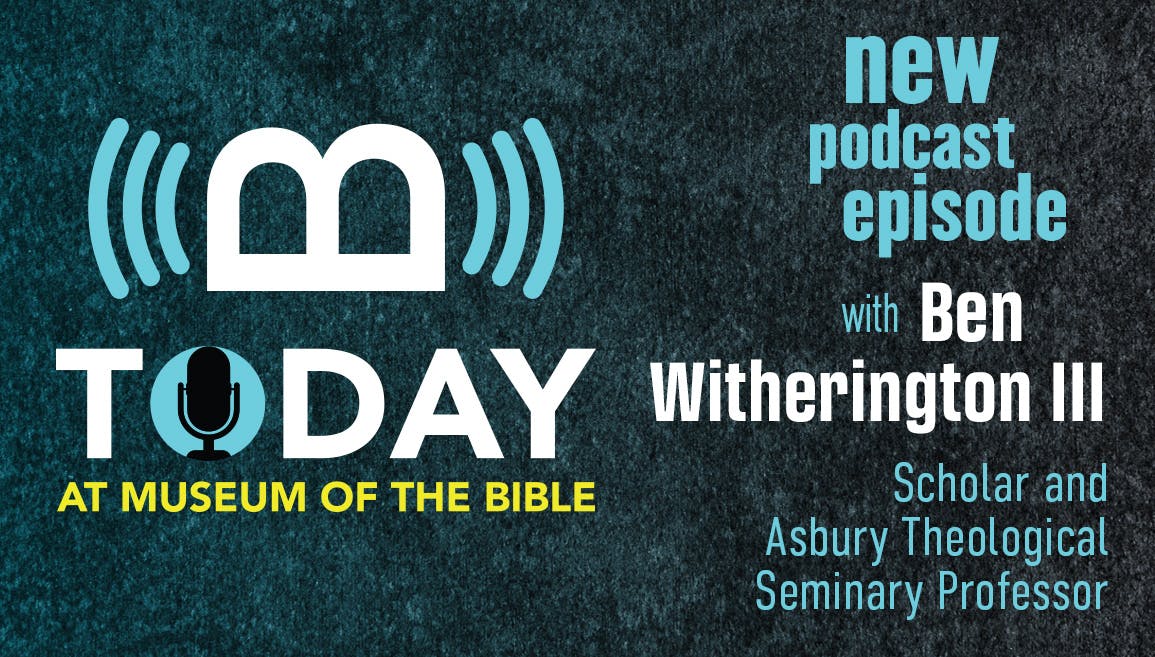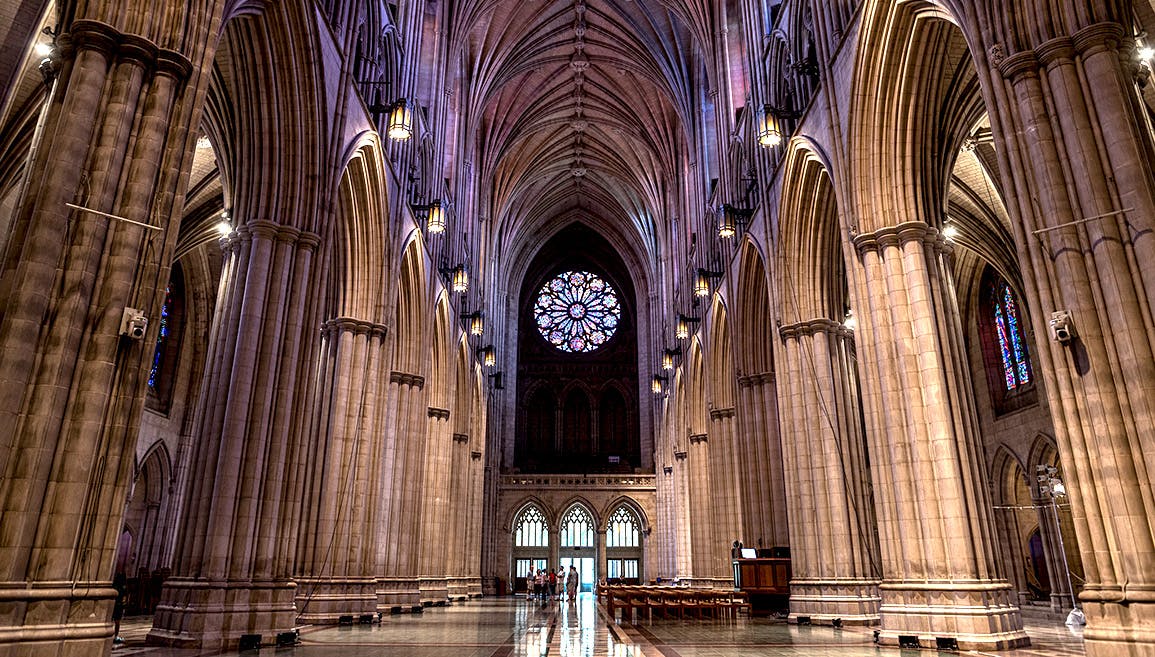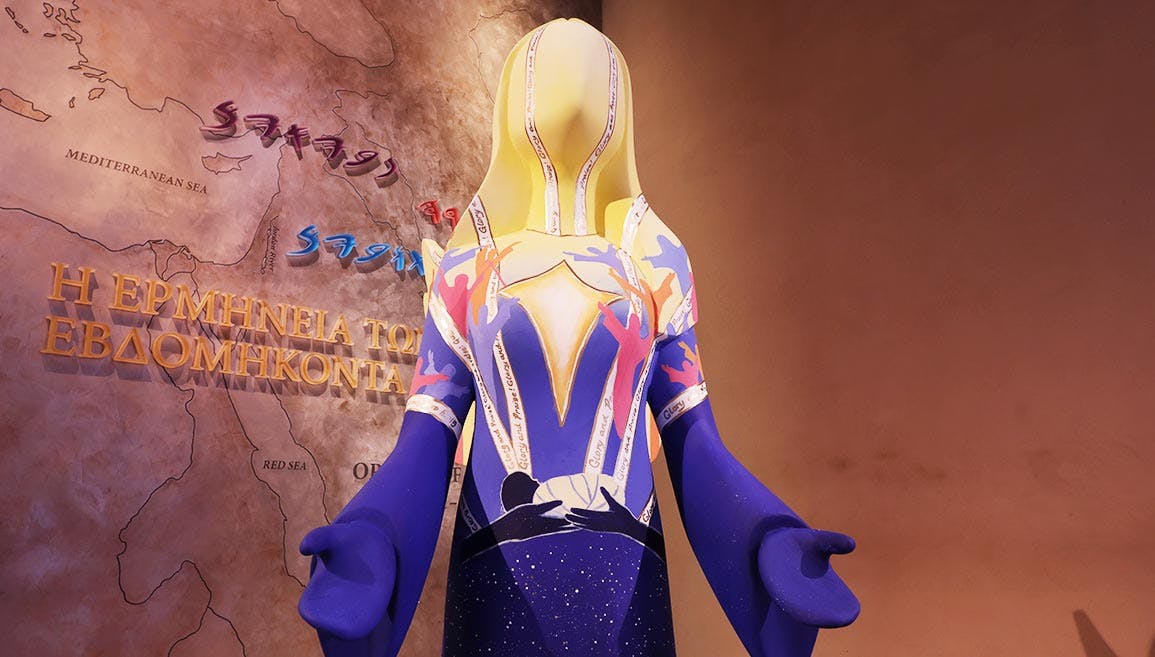Context and Biblical Accounts with Ben Witherington III

Recently on our podcast, Today at Museum of the Bible, Chief Curatorial Officer Dr. Jeff Kloha interviewed renowned New Testament scholar Dr. Ben Witherington III.
The following interview has been edited for clarity and space. To listen to the whole interview, check it here on our podcast.
Jeff Kloha: We’re here today with Dr. Ben Witherington III, longtime, well-respected New Testament scholar, professor at Asbury Theological Seminary, and author of over 60 books. Ben, welcome back to the museum.
Ben Witherington III: It’s good to be back.
Jeff: Ben’s here to be a speaker for the opening of our exhibition on the Church of the Nativity in Bethlehem. You do quite a bit on the context, the historical backgrounds, and the geography of the New Testament. Why is that so important?
Ben: Well, I like to say a text without a context is just a pretext for whatever you want it to mean. The real problem is the Bible gets sound-bited. Sermons are sound bites of some small passage or maybe a parable, but certainly not anything in any lengthy context. So, I like to take them to the lands of the Bible, let them see the places themselves.
And there are exciting discoveries. This past summer, I was in Pisidian Antioch, which is where Paul went on his first missionary journey. But why? Well, he had been to Cyprus, and he visited the governor, Sergius Paulus, who was impressed with him. As it turns out, Sergius Paulus had family connections in Pisidian Antioch.
Mark Wilson and I found in the little museum at Yalvaç, which is Pisidian Antioch, an inscription stone that mentions L. Sergius Paulus—twice. It’s a Latin inscription about L. Sergius Paulus, and it explains why Paul went there. He must have had a letter of introduction from Sergius Paulus. And that’s why when you read Acts 13, he’s welcomed, probably because of the connections.
Jeff: Ben, you’re here to talk about the Church of the Nativity in Bethlehem, especially the New Testament backgrounds of what Bethlehem was in the first century.
Ben: I’m going to talk a little bit about the archaeological work that was allowed to be done underneath and beside the Church of the Nativity a few years ago. And I’m going to talk about how we can connect the evidence from the archaeological work and other archaeological digs in the area near Shepherds’ Field to the biblical stories and how we read the stories differently because of that work.
Jeff: They found Roman materials at the Church of the Nativity. It’s an occupied site and fits the basic description that we have. It’s a light description in the Gospels, but it coheres with what they found in the ground, literally.
Ben: Yeah, exactly.
Jeff: Why the caves? We’re used to seeing a Nativity scene with a stable and wooden manger.
Ben: God bless St. Francis of Assisi. He’s the one who came up with that, let’s park some animals, which he loved, next to some children and Jesus and a shepherd or two and a wise man and a couple of camels and we’re good to go. But that all only goes back to St. Francis, honestly. And one of the problems we have in studying the Bible is mushing all the stories together in our middle Cuisineart. From a historical point of view, the magi came later. The shepherds were there at the time of Jesus being born; the magi came later. And Matthew is very clear that they visited Joseph and Mary and the baby when they were at home. And so, they had obviously stayed in Bethlehem for a good period of time. And if you really read the story carefully, why would Herod say kill all the babies two years and under? Well, because it had been quite a while since this birth.
One of the clearest bits is we know there were houses in this area, at the back of which there would have been a cave. And the cave was used for storage, and sometimes it was used to put the beast of burden in there—you don’t leave it out in the field. It’s the only beast of burden you got. So why was Jesus born and put in a manger in a corn crib? Why is that? Well, probably because the ancestral house was built out of and from a cave, not just entirely in a cave, but out of, from a cave. And sure enough, if you go to Shepherds’ Field, there are all these caves where people have lived. Today, when you go to the Church of the Nativity and you see the spot where they’re claiming the manger was, well, it’s in a cave.
But why were born in a cave enclosure like that? Well, I think Luke explains this. The Holy Family got there late. There were people in the house, and presumably, it was time for her to give birth. What the text says is they came to the house, knocked on the door, but there was no room in the guest room. The Greek does not say there was no room in the inn. Well, as far as we can tell, there was no inn in Bethlehem. It was a one stoplight town. So, you know, the story begins to make some sense. They were supposed to go to register for the census, and they had to go to their ancestral home in Bethlehem. There were already a lot of people there, so they put them in the back of the house when the baby was born.
Jeff: This understanding, the archaeology, the geography, just the social life of the day helps make it three-dimensional.
Ben: And the reason there’s all these shepherds and all these sheep in the field is because Bethlehem was probably the supplier of many of the lambs used for sacrifice in Jerusalem. It’s not that far away.
Jeff: Just a little comment, we often see shepherds depicted as very friendly fellows. What were shepherds like in the first century?
Ben: Well, you know, as my friend Amy-Jill Levine would say, there really isn’t a problem with their uncleanness. Unlike, for example, a tanner, a person who tans the dead hides of animals. They were ritually unclean. Shepherds—not necessarily, but shepherding was a dirty job. I mean, if you’ve ever been around sheep very long, they get in the mud. They were rustics, for sure. They’re ordinary people, but they could also be very devout people. I mean, the idea that most Jews were not that devout has been exploded by the discovery of mikvahs everywhere. Ritual purification baths under houses, in houses, next to houses, next to walls and cities.
So, we’re not surprised to hear that ordinary folk could be quite pious and receive a notice that they needed to get themselves to Bethlehem to see what was about to happen.
Jeff: What’s a site that you would encourage people to go to if they have an opportunity?
Ben: Obviously, the big attraction in Jordan is Petra, and it does have to do with the Bible because the Spice Road went right through it. But if I was going to take them to one biblical site, I’d take them to Jerash because that’s humongous. It’s one of the most well-preserved Roman sites anywhere. The story about the Gerasene demoniac, that was the region that was there. It’s got the forum. It’s got the streets. It’s well worth seeing. Or maybe Mount Nebo and the Madaba church would be good.
In Egypt, I would want to take them to Luxor and see the Temple of Thieves and the Valley of the Kings and Queens and just get a sense of the pharaohs. And then of course, the pyramids in Giza.
In Israel, well, there’s just too much to see. Everybody knows to go to Jerusalem and to go to Galilee and all of that.
The real hidden gem for many Christians is Turkey. Most of early Christianity happened in Turkey and in Greece. As it turns out, Turkey’s good for the Old and New Testament. You’ve got Haran, Mount Ararat, all these cities that Paul visited, and then you have the whole Byzantine Empire. You have all these churches leading up to Hagia Sophia in Constantinople.
Greece is fantastic, both for ancient and modern Christianity. We normally do north to south, so we start in Philippi, we go to Beroea, we go to Thessaloniki, and then we go to Meteora, which is where all the monasteries are. And we go to the Oracle at Delphi, just up from Corinth. We go to Corinth and finish in Athens with the Parthenon. That whole orbit from Corinth all the way up to Philippi is well worth seeing.
And you can go down to the Isthmus [of Corinth] and then they tell you when you get there that this is where the Isthmian Games were every two years. And what did you need at the Isthmian Games? You needed tents, because thousands of people came to the Isthmian Games, and who was it that was selling tents? This was Paul and Priscilla and Aquila. All of a sudden, this makes good sense.
Jeff: If you ever have the opportunity to do a tour with Ben, do it. You’ll have a once-in-a-lifetime experience. Ben, it’s great to have you back. Thanks for joining us today.
Ben: Absolutely. Thank you.


